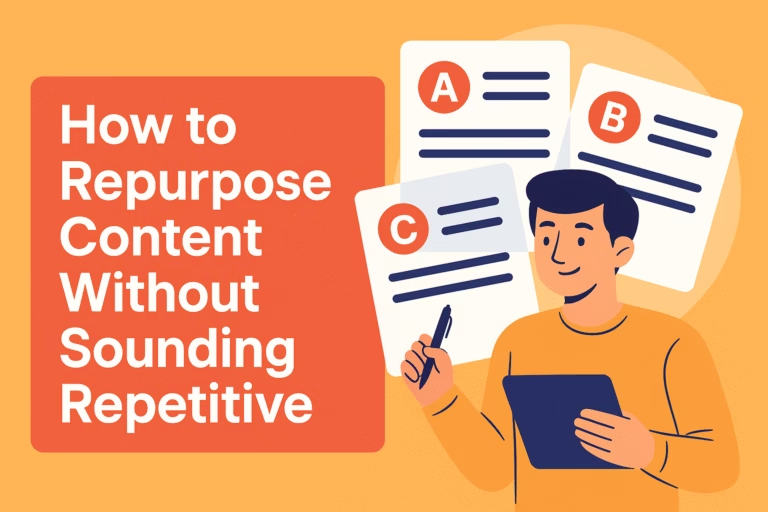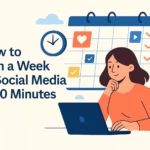Key Takeaways
- Repetition is not creative failure. It’s brand memory. People remember ideas they see often, not the ones they scroll past once.
- The 3×3×3 Model turns one idea into twenty or more unique pieces by shifting perspective, format, and tone.
- Use AI as a partner, not a replacement. Feed it your voice, then edit with emotion to keep every version authentic.
- Blaze Autopilot helps distribute your content across platforms while you stay focused on storytelling and strategy.
- Consistency without creativity becomes noise. Creativity without consistency becomes invisible. The goal is rhythm — not repetition.
- Every post is a remix of what you believe. Say it again, say it better, say it with heart.
Creators treat repetition like a sin. They feel guilty when they revisit a topic they’ve already covered as if every post must be a brand-new invention. But originality isn’t about novelty. It’s about angle.
Every audience member joins your story at a different point. What feels repetitive to you is often the first time they’ve heard it. The algorithm buries posts fast, attention moves faster, and most people won’t remember last week’s caption, let alone last month’s insight.
Think of your core ideas as songs. Great musicians don’t write a new melody every day; they remix their best ones, performing them for new crowds in new venues. That’s how ideas spread through rhythm, not reinvention.
If you’re constantly trying to start from scratch, you’ll burn out long before your audience gets bored. What you need isn’t more ideas. You need a process that stretches one strong idea across platforms, moods, and formats without sounding mechanical.
That’s what we’ll build here: a method that multiplies your message while keeping your tone intact.
The Psychology of Repetition
Here’s a truth most creators miss: people don’t remember your content nearly as much as you think they do. Studies in digital marketing show that audiences need to encounter the same message five to seven times before it fully registers. That’s not redundancy that’s reinforcement.
Repetition builds familiarity, and familiarity builds trust. It’s the same principle that brands use in advertising. Nike doesn’t change its message every week. It changes the angle one day through an athlete’s story, another through a simple line like “Just do it.” The core stays the same.
In content creation, your repetition is what forms identity. When someone can recognize your tone or ideas instantly, that’s brand equity. Every time you reframe a topic, you deepen recognition.
This is also where smart automation helps. A tool like Blaze Autopilot lets you schedule multiple variations of one idea across platforms. Instead of rewriting endlessly, you can test which format — quote post, short reel, or story carousel lands best, while keeping your voice consistent.
The goal isn’t to sound different every day. It’s to sound familiar enough that people remember you, but fresh enough that they keep listening.

The Idea Expansion Formula
Every idea has layers. The problem is, most creators stop at the first one the obvious, surface-level version. The trick to turning one idea into twenty pieces of content is learning how to slice it from multiple angles.
A single concept, like “consistency,” can become a story about failure, a tutorial on habits, a motivational quote, a data-backed insight, or a behind-the-scenes confession. The message doesn’t change the framing does.
To make this systematic, use the 3×3×3 Model:
-
Three perspectives: personal, educational, and observational
-
Three formats: written, visual, and conversational
-
Three tones: inspiring, practical, and humorous
Combine them freely. One topic multiplied through those lenses gives you more than twenty variations — all anchored to your original message.
For example, if your big idea is “showing up matters more than talent”:
-
As a personal story, it becomes “I almost quit, but discipline saved me.”
-
As an educational post, it turns into “The neuroscience of showing up.”
-
As a humorous reel, it becomes “When your 5 a.m. motivation meets 5 minutes of snooze.”
You don’t need new material; you just need new angles. This formula keeps your message consistent while your delivery evolves.
Next, we’ll break it down visually how one idea transforms into many without losing its center.
How to Reframe One Idea
Let’s take a single concept “Consistency beats motivation” and see how it can multiply without feeling recycled.
Each row below shows how changing the format, tone, or angle gives the same core idea new life.
By shifting tone and structure, you transform repetition into range. The audience feels variety, but your message stays unified.
This method also helps with long-term branding your followers start recognizing your voice, not just your posts.
Next, we’ll explore how to use AI as a creative partner to multiply ideas without diluting your originality.
Using AI as a Creative Partner
AI should not replace your creativity; it should stretch it. The fastest way to multiply your ideas is to work with AI tools as thought partners, not ghostwriters. You feed them the raw concept, and they return new formats, tones, or metaphors that you might not have considered.
Start by writing your original idea clearly in one or two sentences. Then prompt your AI to reimagine it from different angles. Ask, “How would this sound as a story?” or “What if this were explained in one funny line?” The goal is to unlock perspectives you might miss on your own.
You can also train AI to understand your style. Give it examples of your posts that performed well, along with notes about your tone. When the system starts to recognize your phrasing patterns, it produces drafts that sound closer to your real voice.
Once you have your twenty variations, you still need to distribute them smartly. That is where Blaze Autopilot fits naturally. It helps you schedule different versions of your content across platforms, measure what resonates most, and maintain a steady posting rhythm without losing authenticity.
The secret is simple. Let AI assist in creation, and let automation handle delivery. But keep the final judgment for yourself. Every idea still passes through your instincts before it reaches your audience.
Next, we will talk about how to polish these AI-assisted drafts and keep each version sounding human and distinct.
The Human Edit Layer
This is where real creators separate themselves from automation. AI can multiply ideas, but only you can make them matter. The human edit layer is not about fixing grammar or phrasing. It’s about restoring soul.
Before you post any AI-assisted draft, read it aloud. You will hear what feels stiff or unnatural. Machines write for logic. Humans write for rhythm. If a sentence doesn’t sound like something you would say, rewrite it. If it sounds too polished, roughen it a little. A well-placed imperfection builds trust.
Next, weave in personal texture. Drop in a real story, a specific example, or a micro detail that could only come from your life. Audiences crave proof that there’s a person behind the post. When you let glimpses of your day, voice, or humor slip in, you reintroduce humanity into the workflow.
Consistency is good. Sameness is not. Your edits give each version its unique emotional fingerprint. Whether it’s a caption, thread, or short video script, one moment of sincerity transforms an otherwise generic post into something memorable.
That is what people respond to — not the idea itself, but the feeling that someone meant it.
Now, to close this out, we will step back and reflect on what creative repetition really means for a modern creator.
Winding Up
Every creator eventually learns the same lesson: originality is overrated, but clarity never is. You don’t need a thousand ideas. You need one good one, delivered consistently in a hundred different ways that still sound like you.
When you build a system around that truth, creativity stops being stressful. You stop chasing inspiration and start shaping it. One idea becomes a library of content instead of a single post that disappears by morning.
AI and automation are not threats to creativity. They are multipliers of it.
The creators who thrive long term are not the loudest or the luckiest. They are the ones who found a rhythm between technology and intent. They build once, test smart, and communicate with feeling.
So stop treating your ideas like one-use items. They deserve more life than a single scroll. Stretch them, remix them, and let them travel further than you can alone.
That is how a single thought grows into influence. Not by shouting louder, but by echoing smarter.



